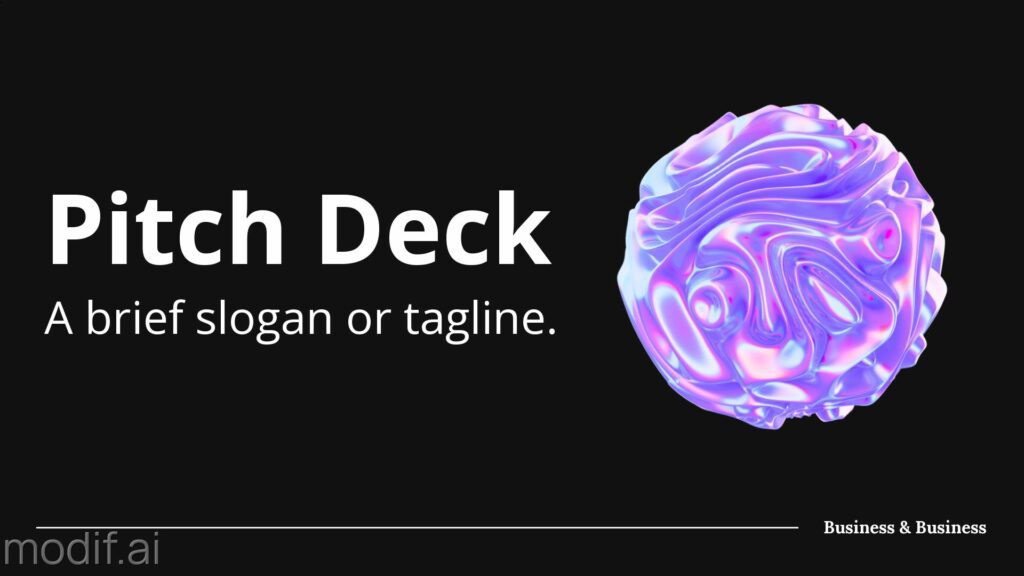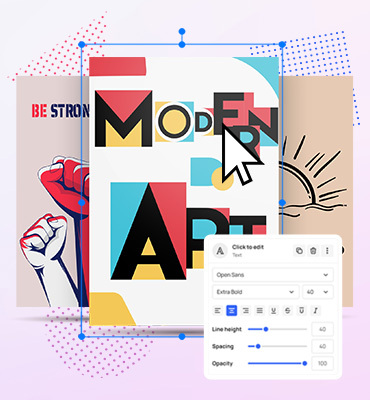Is a Pitch Deck a Visual Slide Presentation? (+ Templates)
If you’ve ever needed to convince investors, clients, or colleagues, you’ve probably built a presentation to tell your story. But when it comes to pitching an idea or a startup, a standard slideshow won’t do. You need something more intentional, more visual, and more persuasive. So, is a pitch deck a visual slide presentation? Absolutely.
A pitch deck is a concise, highly visual collection of slides designed to communicate your message quickly and clearly. It’s part storytelling tool, part design exercise — and when done right, it can make the difference between a polite “thanks” and a solid “yes.”
In this guide, we’ll break down what makes a pitch deck visual, how to design one that stands out, and share ready-to-use templates from MediaModifier to help you create professional slides in minutes.
What is a Pitch Deck?
A pitch deck is a short, visual slide presentation used to share an idea, business concept, or project in a clear and engaging way. It’s most commonly used by startups seeking investment, but also by freelancers, marketing teams, and entrepreneurs pitching new ideas or campaigns.
Unlike a long-form report or written proposal, a pitch deck focuses on storytelling through visuals. Each slide should communicate one key idea — supported by concise text, strong imagery, and clean design. The goal isn’t just to inform; it’s to persuade and inspire confidence.
A pitch deck typically includes slides that cover:
- The problem you’re solving
- Your proposed solution
- The market opportunity
- Your product or service
- Business model and traction
- Team and next steps
In other words, a pitch deck is a visual slide presentation built to make people understand your vision. It blends strategy, communication, and design into a format that captures attention from the very first slide.
So, is a Pitch Deck a Visual Slide Presentation? (Answer: Absolutely)
The short answer is yes, a pitch deck is a visual slide presentation, but with a specific purpose: to communicate ideas in a clear, emotional, and visually appealing way. While traditional presentations rely heavily on text and bullet points, a great pitch deck speaks through design.
A highly visual pitch deck combines concise storytelling with strong visuals to keep your audience engaged. This means:
- Minimal text (each slide communicates one core idea).
- Consistent color palette and typography.
- Strategic use of icons, charts, and photography to illustrate points.
- Balanced layouts that guide the viewer’s eyes naturally.
Research shows that visuals help people retain information better — up to 65% more than through text alone. That’s why pitch deck visuals are critical: they don’t just decorate your slides; they make your story memorable.
If you’re unsure how to start, explore templates like MediaModifier’s Minimal Pitch Deck Template. It’s a great example of how simplicity, clean typography, and balanced spacing create slides that look professional without overwhelming your audience.
In short, a pitch deck isn’t just a slideshow. It’s a visual storytelling tool designed to make complex ideas easy to grasp and impossible to ignore.

The difference between a Pitch Deck and a regular presentation
At first glance, a pitch deck and a presentation might look the same — both involve slides, visuals, and a speaker. But their purpose, tone, and structure set them apart.
A regular presentation is designed to inform or explain. Think of a classroom lecture, quarterly business review, or internal update. These slides are often text-heavy, filled with data, and meant to support a detailed spoken narrative.
A pitch deck, on the other hand, is built to persuade. It’s not about dumping information. It’s about shaping a story that moves your audience toward a decision. The visuals take center stage, while the text simply reinforces the message. Every slide should answer one question: Why should they care?
Here’s how they differ:
- Purpose: Informative vs. persuasive
- Length: Longer vs. concise (usually 10–15 slides)
- Tone: Neutral vs. emotional
- Design: Functional vs. highly visual
If you compare a standard corporate slideshow with a pitch deck, the difference is obvious. A good pitch deck feels like a visual journey — simple, confident, and consistent.
You can see that in MediaModifier’s Business Pitch Deck Template, which combines structure and storytelling with modern design layouts.
In short, a presentation delivers information, while a pitch deck delivers impact.
What makes a Pitch Deck highly visual
A great pitch deck isn’t just made of slides. It’s built around visual clarity. The best decks use design not as decoration, but as a way to simplify complex ideas and make them instantly understandable. So, what actually makes a pitch deck highly visual?
1. Minimal text, maximum focus
Each slide should deliver one key message. Use short phrases, not paragraphs. Let visuals and icons do the heavy lifting.
2. Consistent visual language
Stick to a unified color palette, typography, and icon style throughout the deck. Consistency signals professionalism and helps your audience follow along smoothly.
3. Strong visual hierarchy
Make it easy for the viewer’s eye to know what to look at first. Use bold headlines, white space, and contrast to direct attention.
4. Supporting visuals, not filler
Every image, graph, or illustration should clarify an idea — not distract from it. Avoid stock images that don’t feel authentic to your brand or story.
5. Balance between design and storytelling
Even the most beautiful slides fall flat without a coherent narrative. Pair visuals with a compelling story arc — from the problem to the solution, to the call to action.
You can see these principles in action in MediaModifier’s Modern Pitch Deck Presentation Template. It’s structured for clarity and visual impact, making it easier for any idea to stand out.
When design and storytelling work together, your slides don’t just look good — they feel convincing.
How to make a Pitch Deck that looks professional
Designing a professional pitch deck isn’t about having advanced design skills. It’s about clarity, structure, and consistency. Whether you’re presenting to investors, clients, or executives, the goal is to make your message instantly understandable and visually appealing. Here’s how to approach making a pitch deck that feels polished and credible.
Step 1: Define your story first
Before you touch a design tool, outline the story you want to tell. What’s the problem, and how are you solving it? Your slides should guide the audience through that narrative from start to finish.
Step 2: Build a logical structure
Most successful decks follow a flow: problem → solution → opportunity → product → proof → call to action. This structure keeps your audience engaged and prevents overload.
Step 3: Design with intention
Choose a clean, readable font, and stick to a limited color palette. Keep plenty of white space around elements so your slides don’t feel crowded.
Step 4: Use visuals strategically
Images, icons, and charts should simplify your message, not complicate it. Avoid clip art or overused stock photography. Choose visuals that match your tone and message.
Step 5: Test your slides in context
Preview your deck in a realistic setting before presenting it. For example, upload it to a pitch deck mockup to see how it would look in a real boardroom environment. It’s a subtle touch that makes your presentation feel more professional and confident.
When you combine a clear message with thoughtful design, your slides stop being just “visual aids” — they become part of your pitch strategy.
Best Pitch Deck Mockup Templates to try
If you want your presentation to stand out, the right mockup template can make all the difference. Instead of starting from a blank canvas, you can customize pre-designed layouts that are already structured for clarity, balance, and visual appeal.
Here are some of MediaModifier’s best pitch deck mockup templates you can try right now:
1. Abstract Pitch Deck Template
This clean and modern layout keeps the focus on your message. With bold typography, minimal color accents, and spacious slides, it’s ideal for startups or creatives who want their ideas to breathe.

2. Business Pitch Deck Template
Built for entrepreneurs and marketing professionals, this deck template balances visual storytelling with professional tone. It’s perfect for presenting data, growth charts, and business insights while maintaining a polished corporate look.

3. Modern Pitch Deck Presentation Template
This design combines dynamic layouts with elegant visuals, giving your slides a contemporary, tech-oriented feel. It’s especially suited for SaaS startups, creative agencies, or product demos.

4. Corporate Pitch Mockup for Showcase
If you want to visualize how your deck will look in a real presentation environment, this mockup template is perfect. It places your slides in a realistic corporate setting, helping you preview your presentation in action before the big day.

Using ready-to-edit templates like these helps you save time and focus on your story rather than design details. Plus, they ensure your slides look cohesive, confident, and presentation-ready — no matter your design background.
Tips for Strong Pitch Deck Visuals
Even the best ideas can fall flat if the visuals don’t support them. Great pitch deck visuals do more than make slides look pretty. They make your message easier to understand and remember. Here’s how to elevate your design from simple slides to powerful visual storytelling:
1. Prioritize clarity over complexity
Avoid overcrowding your slides with text or too many visuals. Each slide should communicate a single idea. Simplicity keeps your audience focused and helps your message land.
2. Use contrast to guide attention
Contrast between colors, font weights, and background shades helps highlight key points. This ensures that your audience immediately sees what matters most.
3. Keep your typography consistent
Stick to one or two font families across your entire deck. Use size and weight variations (not multiple fonts) to build hierarchy and rhythm.
4. Choose meaningful imagery
Images should support your story, not distract from it. Skip generic stock photos and use visuals that represent your brand’s tone, industry, or product.
5. Balance text and visuals
Think of every slide as a composition. White space, alignment, and symmetry are as important as the words you use. A balanced layout feels more professional and easier on the eyes.
6. Preview your slides in context
Before you present, visualize how your deck will appear on a screen or in a real-world setting. MediaModifier’s mockups make this step easy: you can instantly see how your deck performs visually before sharing it with clients or investors.
By treating visuals as part of your storytelling strategy, your pitch deck becomes more than a simple presentation.
Conclusion
So, is a pitch deck a visual slide presentation? Absolutely. But it’s much more than that. A great pitch deck doesn’t just share information; it tells a story. It uses visuals, structure, and design to make your audience feel something: curiosity, confidence, or excitement about what you’re offering.
Whether you’re pitching a startup, presenting to clients, or preparing for an internal meeting, the goal is the same: keep it simple, keep it visual, and keep it focused. With the right templates and mockups, anyone can create a deck that looks polished and professional without spending hours on design.
Ready to build your next presentation? Start with one of MediaModifier’s pitch deck templates and transform your ideas into clear, compelling visual stories that win attention.
Frequently Asked Questions about pitch deck templates
What is another name for a pitch deck?
A pitch deck is sometimes called an investor deck, presentation deck, startup deck, or slide deck. While the terms are often used interchangeably, “pitch deck” typically refers to presentations designed to persuade or attract investment.
What makes a pitch deck highly visual?
A highly visual pitch deck focuses on simplicity, contrast, and storytelling. Each slide uses minimal text and strong visuals — icons, images, or charts — to convey ideas quickly. Good design leads the viewer’s eyes naturally through the story, without overwhelming them with clutter.
What should each slide in a pitch deck include?
Each slide should focus on one idea. Common sections include the problem, solution, product, market, business model, traction, and call to action. Every slide should have a clear headline, a concise message, and supporting visuals.
How long should a pitch deck presentation be?
Most professional decks are between 10 and 15 slides. The goal is to hold attention and communicate only what’s essential. Investors and clients prefer concise, focused decks that make their point without extra filler.
Is a pitch deck the same as a PowerPoint presentation?
Not exactly. While a PowerPoint presentation can cover any topic, a pitch deck has a specific purpose — to persuade. It’s shorter, more visual, and designed to build excitement and confidence in your idea or product.
Can I make a pitch deck online without PowerPoint?
Yes. Tools like MediaModifier allow you to design and preview your deck directly online. You can choose templates, customize visuals, and even display your slides using realistic mockups — no PowerPoint or advanced software required.
What are the best tools for creating pitch deck visuals?
Online tools like MediaModifier and Google Slides make it easy to design clean, professional slides. MediaModifier stands out because it also lets you mock up your pitch decks in realistic settings — perfect for client previews or social sharing.
What’s the difference between an investor deck and a marketing deck?
An investor deck focuses on the business side: growth, traction, financials, and team. A marketing deck, meanwhile, emphasizes brand visuals, campaigns, and creative direction. Both rely on strong design to communicate ideas clearly and persuasively.
How do I use mockups to preview my pitch deck?
Upload your slides to a mockup template on MediaModifier, such as the Corporate Pitch Mockup for Leadership Messaging Showcase. This lets you visualize how your presentation would look on a real screen or device — adding professionalism to your preview.
Related articles
Visualize your design Use a product mockup to showcase your design


Create your design Use our templates to create delightful designs for any medium


